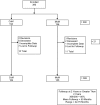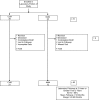No Difference in Reoperations at 2 Years Between Ceramic-on-metal and Metal-on-metal THA: A Randomized Trial
- PMID: 26135473
- PMCID: PMC4709319
- DOI: 10.1007/s11999-015-4424-5
No Difference in Reoperations at 2 Years Between Ceramic-on-metal and Metal-on-metal THA: A Randomized Trial
Abstract
Background: Hard-on-hard bearings for total hip arthroplasty continue to warrant analysis even though crosslinked polyethylene is performing very well. Ceramic-on-metal (CoM) has low in vitro wear and did well in an early clinical trial. We report on a prospective, randomized, multicenter investigational device trial comparing CoM with metal-on-metal (MoM).
Questions/purposes: (1) Is there a difference in the number or type of revisions comparing CoM with MoM? (2) Are cobalt and chromium metal levels different for CoM and MoM THA?
Methods: Between August 2005 and October 2006, of 1015 patients screened, 390 patients were enrolled at 11 centers and randomized to 194 CoM and 196 MoM bearings. There was no difference in the preoperative patient demographics between the study groups. Mean followup was 50 months (range, 22-75 months). Seventy-two patients from two centers had metal level analysis.
Results: With the numbers available, there was no difference in the proportion of patients undergoing revisions between the MoM and the CoM cohorts (MOM: 3% [six of 196]; COM: 1.5% [three of 194]; p = 0.50). Four MoM revisions were unrelated to the bearing surface. Two had bearing surface-related reoperations, one for an aseptic lymphocyte-dominated vasculitis-associated lesion and one for elevated metal levels with acetabular malposition. None of the CoM revisions were related to the bearing surface. The metal level analysis revealed that in contrast to the CoM, the MoM bearing group had increasing values of erythrocyte and serum cobalt from 1 to 5 years (CoM erythrocyte 0.45-0.55 ppb, p = 0.11 and CoM serum 0.88-0.85, p = 0.55, and MoM erythrocyte 0.32-0.51 ppb, p < 0.01 and MoM serum 0.65-1.01 ppb, p < 0.01). In addition, the MoM cobalt levels in erythrocytes and serum at 5 years were more variable than at 1 year (erythrocyte interquartile range [IQR], 0.26-0.44 to 0.31-1.21 ppb and serum IQR, 0.42-0.80 to 0.64-2.20 ppb, p < 0.02 for both).
Conclusions: Although both bearings performed well at short-term followup, the CoM bearing group had no wear-related revisions and maintained consistently low metal levels. The MoM cobalt elevations may be important considering recent reports of taper corrosion. This CoM bearing was approved by the FDA but withdrawn from the market because of low sales. If it were available, the authors would not use CoM until long-term data were available. The bearing would have to outperform crosslinked polyethylene because it is unlikely that CoM metal levels will return to normal.
Level of evidence: Level I, therapeutic study.
Figures




Comment in
-
CORR Insights(®): No Difference in Reoperations at 2 Years Between Ceramic-on-metal and Metal-on-metal THA: A Randomized Trial.Clin Orthop Relat Res. 2016 Feb;474(2):456-8. doi: 10.1007/s11999-015-4487-3. Epub 2015 Aug 20. Clin Orthop Relat Res. 2016. PMID: 26290340 Free PMC article. No abstract available.
References
-
- Australian Orthopaedic Association National Joint Replacement Registry. Metal on Metal Bearing Surface Total Conventional Hip Arthroplasty Supplementary Report 2014. Available at: https://aoanjrr.dmac.adelaide.edu.au/documents/10180/172288/Metal%20on%2.... Accessed May 13, 2015.
-
- Cigada A, Cotogno G, Chiesa R. The ceramic-on-metal coupling in total hip replacements for young patients: a review study. J Appl Biomater Biomech. 2011;9:2–10. - PubMed
Publication types
MeSH terms
Substances
LinkOut - more resources
Full Text Sources
Other Literature Sources
Medical
Research Materials

